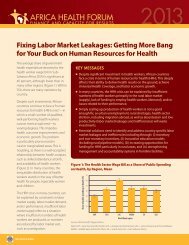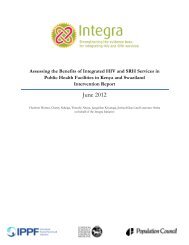ujh78
ujh78
ujh78
You also want an ePaper? Increase the reach of your titles
YUMPU automatically turns print PDFs into web optimized ePapers that Google loves.
5 Shelter Deprivation<br />
This chapter focuses on two household characteristics: dwellings with mud floors and homes that<br />
do not have electricity. The analyses included data on children up to 17 years of age.<br />
5.1 Living in Houses with Mud Floors<br />
The growing number and size of slums worldwide demonstrates that the slums are crucial<br />
elements of contemporary urbanization in developing countries (Morakinyo et al., 2012). Over 640<br />
million children in the developing world live in overcrowded homes or dwellings with mud floors<br />
(UNICEF, 2005). Researchers have found an association in sub-Saharan Africa between living in houses<br />
with mud floors and health and nutritional problems. Dumba et al. (2008) found in the Luweero district of<br />
Uganda that, among children under age 5, living in a house with a mud floor was associated with the risk<br />
of having helminth infection. Ainsworth and Semali (2000), studying children under the age of 60 months<br />
in the Kagera region of Tanzania, found an association between a recent adult death in households with a<br />
dirt floor and substantially higher child morbidity. Ainsworth and Semali also found that better housing<br />
(e.g., having a concrete, tiled, or wooden floor instead of a dirt floor) was the only household-level<br />
socioeconomic variable with a strongly positive relationship to children’s weight-for-height. Children in<br />
households with concrete, wood, or tile floors had weight-for-height z-scores 0.2 SD higher than children<br />
in households with dirt floors. Finally, a recent study by Mohammed and Tamiru (2013) in Arba Minch<br />
Zuria, southern Ethiopia, found that children under five years old living in houses with mud floors were<br />
more likely to have diarrhea than their counterparts living in houses with cement floors.<br />
In sub-Saharan Africa the percentage of children under 18 years of age who lived in houses with<br />
mud floors was very inconsistent, from 16% in Madagascar to 95% in Chad (see Map 5.1). In Burundi<br />
and Ethiopia 9 of every 10 children lived in a house with mud floors (see Table 5.1). Three of every four<br />
children lived in houses with mud floors in Malawi, Mali, Niger, Tanzania, and Uganda. More than half<br />
of children in Burkina Faso, Guinea, Kenya, Liberia, Mozambique, Namibia, and Zambia, as well, lived<br />
in houses with mud floors.<br />
Sex and geographic disparities<br />
Generally, there were no child sex disparities related to living in a house with a mud floor (see<br />
Figure 5.1). However, in four countries—Cameroon, Kenya, Liberia, and Tanzania—the percentage of<br />
children living in houses with mud floors was about 2 percentage points higher for boys than girls (see<br />
Table 5.1).<br />
In every country the percentage of children living in houses with mud floors was higher in rural<br />
areas than in urban areas (see Figure 5.2). This disparity reached more than 60 percentage points in<br />
Guinea, Kenya, Liberia, and Namibia, and in Zambia the difference was 70 percentage points. In Burkina<br />
Faso, Burundi, Cameroon, Malawi, Niger, Tanzania, and Uganda as well, the difference exceeded 50<br />
percentage points (see Table 5.1).<br />
The role of the household head’s sex and age<br />
In two-thirds of these sub-Saharan African countries, the percentage of children living in houses<br />
with mud floors was higher for children living with a male rather than a female head of household (see<br />
Figure 5.3). This difference was about 15 percentage points in four countries—Burkina Faso (male<br />
household head: 60% and female household head: 44%), Guinea (56% and 40%), Nigeria (43% and<br />
28%), and Senegal (41% and 22%) (see Table 5.1). The inverse appeared in Namibia, where the<br />
percentage of children living in a house with mud floors was nearly 10 percentage points higher for<br />
87








